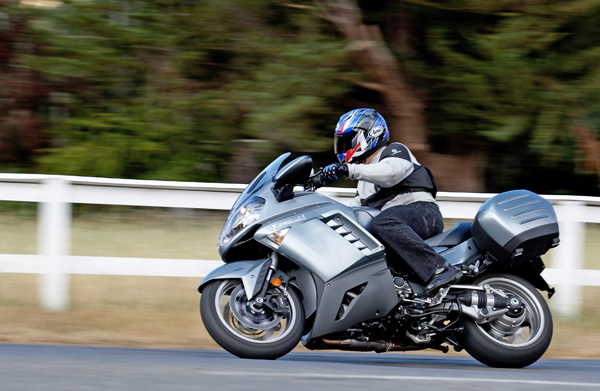
After Part 1 of this riding impression (found here), we put another 200 miles on the 2008 Kawasaki Concours 14 in beautiful Northern California, combining tight twisty roads with high speed freeway travel, and everything in between.
While it retained the name “Concours”, the new Concours 14 is light years beyond the dated machine it replaces in terms of technology. With this bike, Kawasaki effectively vaults from having one of the oldest sport tourer designs on the market to arguably the most state-of-the-art.
With 1352cc of displacement and variable valve timing, the Concours 14 engine sits at the head of the table with regard to power, torque and flexibility. Features like ABS brakes with radial-mount brake calipers (a non-ABS version is also available), ram air induction, adjustable inverted forks (rebound and preload), hydraulically-controlled slipper clutch, and advanced generation over-the-top monocoque aluminum frame (employing the engine as a stressed member) make the Concours 14 spec sheet more impressive than some track-ready sport bikes, as well.
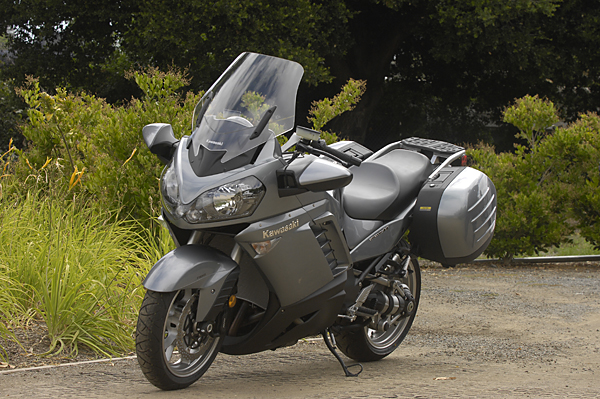
Of course, the Sport Touring game is all about “having your cake and eating it too”. True sport bike performance combined with long-range comfort, including luggage and reasonable pillion accommodations. In this regard, Kawasaki endowed the new Concours 14 with an electronically adjustable windscreen (a stepless design), removable saddlebags, and reasonably upright ergonomics. Chain maintenance is eliminated with shaft drive (a Tetra-lever design, discussed further below), and even tire pressure can be monitored while on the move from the cockpit.

A number of things are worth noting about the Concours 14 engine. Although it is based on the ZX-14 engine, there are a number of significant differences. The most notable is the existence of variable valve timing. The intake cam timing is hydraulically advanced or retarded depending on a computer assessment of rpm and throttle position factors. In addition, fuel injection throttle bores drop from 44 mm to 40 mm, and the exhaust is a 4 into 2 into 1 design (the ZX-14 has 2 mufflers).
When I first heard that the Concours 14 had variable valve timing, I was a bit confused as to the purpose served. After all, the ZX-14 certainly has plenty of low-end torque, and could be tuned without variable valve timing to have huge low-end torque. Do you really need variable valve timing when you start with a modern 1352cc, four-cylinder engine? After riding the bike, I think I now understand why Kawasaki did this.
The engine performance of the Concours 14 reflects the efforts made by Kawasaki’s engineers to maximize power, useability and smoothness. The engine still has a secondary balancer, and is extremely smooth in operation (just like the ZX-14), but the power delivery is far more linear than that of the ZX-14. We have not put the new Concours on a dyno, but huge torque comes on very quickly right above idle, and without a “hit”. It ramps up smoothly, but quickly, and torque seems to be available just about everywhere on the tach.
You might expect a motor this powerful (a claimed 156 HP at 8,800 rpm and 103 lb./ft. at 6,200 rpm) to be intimidating. On the contrary, I found the Concours 14 so easy to ride that its speed could be slightly deceiving. This bike is extremely fast, but, at the same time, it seems to do exactly what you want it to do. Just be prepared for those corner entries to arrive a lot quicker than you are used to.
Which brings us to the subject of brakes. On the ABS version, as well as the non-ABS version, the brakes operate independently (i.e., this is not a “linked” braking system). The front brake is absolutely state-of-the-art. Squeezing huge 310 mm discs are radially mounted four-piston, four-pad calipers that stand with the best braking systems found on any modern sport bike and exceed the performance of several. The rear disc measures 270 mm (20 mm larger than the rear disc found on the ZX-14), and is operated by a far less sophisticated, but nevertheless effective caliper design.
The front brake master cylinder is a direct actuation, radial pump design (also as good as it gets on any modern sport bike). Those four separate pads found in each front caliper are designed to dissipate heat better than a single pad, and also provide multiple leading edges for better initial bite.
A very important aspect of the Concours 14 performance is the shaft drive system. Many sport tourers feature shaft drive primarily to eliminate the maintenance associated with chain drive. The Kawasaki Tetra-lever shaft serves this purpose, but it also features specific design elements intended to reduce or eliminate driveline lash – the bane of many shaft drive motorcycles.
In keeping with its long-range touring function, the Concours 14 has thorough instrumentation. In addition to the relatively unique tire pressure sensor display, the bike has a large analog tach and speedometer, and a LCD screen that is capable of switching to several information screens. In all, the rider can access a fuel level gauge, odometer, two trip meters, a clock, fuel mileage range, fuel consumption (providing both an average and the current mpg), battery voltage and gear position.
The instrumentation is very easy to read. Kawasaki has certainly learned from a mistake it made in the design of its tachometer on sport bikes a few years ago. These instruments feature excellent legibility and contrast. I had no trouble reading the LCD screen during the daylight conditions I encountered. The white-on-black analog instruments are also perfectly legible and functional. A triumph of practicality over fashion!
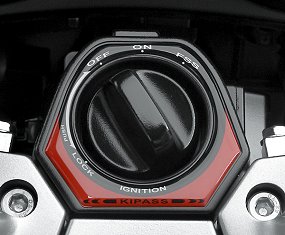
Another interesting bit of technology on the new Concours 14 is KIPASS (which stands for Kawasaki’s Intelligent Proximity Activation Start System). The system boils down to this: For the most part, the key stays in the ignition. You carry a fob with you that allows you to start the motorcycle when the fob is within 5-1/4 feet of a sensor located centrally on the motorcycle. With the fob in a pocket, you walk away from the motorcycle and it becomes impossible to start. In fact, the key cannot be turned once you leave the vicinity of the motorcycle. As you can see from the picture, there are four positions for the key, including Off, On, FSS (which stands for “fuel-seat-storage”) and Steering Lock.
The key can only be removed when in the FSS position, which allows you to use that key to open the fuel tank, remove the seat, or gain access to the lockable saddle bags. When you approach the bike with the fob in your pocket, you push down on the key to activate the system. This allows you to turn the key to the On position and start the motorcycle.
The KIPASS system is a bit strange at first. We are used to traditional keyed ignitions (with very few exceptions – Harley-Davidson has a somewhat similar fob-activated ignition system). After just two days, however, I didn’t really have to think about how to operate KIPASS, and it ceased to present any issues for me. Is carrying a fob more convenient than carrying a key? You decide.
When we began riding the bike, as we usually do at press introductions, we rolled down some city streets and hopped onto a freeway. First impressions concern ergonomics, comfort and engine smoothness. As I said in Part One, the bike felt a bit wide at the foot pegs, and it is quite tall. If you are “inseam challenged”, you better sit on a Concours 14 at the dealership, and rock it back-and-forth before deciding whether you can comfortably get your feet down at stop lights.
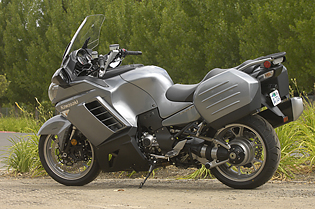
The bike is big and relatively heavy (a claimed 615 pounds dry for the ABS version), but it doesn’t feel that heavy standing still or at low speeds. I attribute this to the low center of gravity (more about that later).
Pulling away and riding through stop-and-go traffic highlighted the smoothness of the fuel injection and the predictable take-up of the clutch. The seating position is comfortable, with your back upright and a reasonably short reach to the handlebar grips. The width of the bar feels about right, providing good leverage, but not being overly wide.
You sense the mechanical nature of the functions occurring beneath you in the motor, the clutch, and even the shaft drive, but only in a pleasant way. The carefully balanced motor is just as smooth (if not smoother) than the motor found in the ZX-14, with seamless fuel injection and throttle pick-up. The massive, but easily controlled thrust down low is great fun to use.
Out on the freeway, you are in a world all your own compared to the cars around you (as you are on most motorcycles). The instant thrust available with a slight turn of your right wrist allows you to move in and about automobiles effortlessly. There is not much available (with four wheels or two) that can challenge the roll-on acceleration at your disposal on the Concours 14.
The six-speed transmission features a very tall overdrive sixth gear, but roll-on power is plenty strong, even from relatively low rpm levels. Sixth gear is so high, however, and the engine so smooth, you may find yourself (as I did) riding on the freeway at elevated speeds in fifth gear . . . not realizing you have a gear left until you happen to glance at the gear position indicator.

Wind protection is excellent. Stock, the Concours 14 features a relatively small windscreen (by heavy sport tourer standards), but I loved the combination of wind protection and low buffeting. More often than not, I find larger windshields create greater buffeting at the shoulder and head level. The Kawasaki design allows plenty of air to enter underneath the adjustable screen, which seems to balance both buffeting and the vacuum effect found on some bikes (which tend to pull you toward the screen). The smaller windscreen also avoids the heavy, front-end loading that results from many, larger windscreen designs found on competitors’ motorcycles. A larger screen will be available from Kawasaki, and undoubtedly many aftermarket companies will get in on the act, eventually. Windscreen protection can be highly subjective, but I liked the stock screen, and can’t imagine changing it.
Wind protection elsewhere is excellent. Keeping your legs tucked into the bike keeps them largely out of the wind. Kawasaki integrated detachable leg shields, which allow you to adjust air flow to your legs depending on the weather. The relatively high seat and low foot pegs provide plenty of leg room, which is also important on longer trips.
As we take the bike into the twisties, and begin to ride more aggressively, the handling characteristics of the Concours 14 come into focus. This bike is extremely stable in a straight line, but somehow manages to be reasonably flickable for such a large machine.
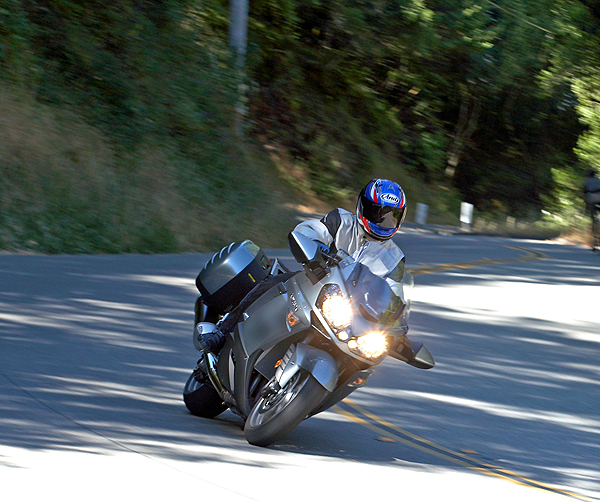
Despite a wheelbase 60 mm longer than the ZX-14, the Concours 14 actually feels better balanced. Its behavior also is consistent with a very low center of gravity. By that I mean it dives very little under heavy braking, and squats very little under heavy acceleration. The bike remains relatively “flat”, which is very important when you are hustling though meandering canyons.
The ABS brakes never failed us, despite extremely aggressive riding, and frequent, heavy use. The Concours 14 can be hauled down very quickly, and very controllably. The ABS pulsing you feel when stomping on your automobile brake pedal can also be felt through the front brake lever and rear brake pedal on the Concours 14 from time-to-time, more often with the rear pedal. Nevertheless, this did not detract from braking control, and ultimately faded from my thought process while riding the bike hard.
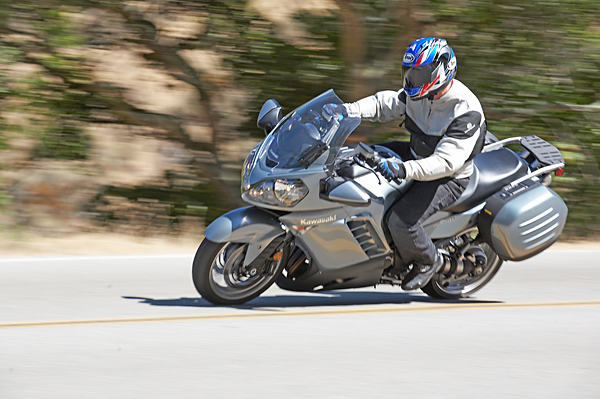
The bike transitions well from side-to-side, as I said earlier, but it also holds a line very well mid-corner. The lean angle available is very generous for a sport tourer of this size (and virtually identical to the stock ZX-14). I touched the toe of my boots down on both sides, but never scraped a foot peg or any other hard part on the machine, despite attacking corners harder than most Sport Tourers ever would.
I never touched the suspension settings, and Kawasaki indicated that the fork was left in its stock position, while minor adjustments were made to the shock settings before the journalists boarded the bikes. The damping and rebound control seemed outstanding. Reasonable comfort while cruising was combined with outstanding control and feedback while riding aggressively through the twisties.
The slipper clutch also worked flawlessly. Despite aggressive downshifts, the rear wheel stayed planted and rolling on corner entries.
At one point on the ride, on the second day, I felt quite a bit of heat coming off the engine onto my legs. This was a bit strange, because I did not experience the same thing at any other time during the 400 miles of testing. We had been riding at a very rapid pace, pushing the bikes very hard, and the air temperature was pretty high. I don’t know that heat would be an issue for most riders under most circumstances, and it certainly did not change my ultimate opinion about the Concours 14.
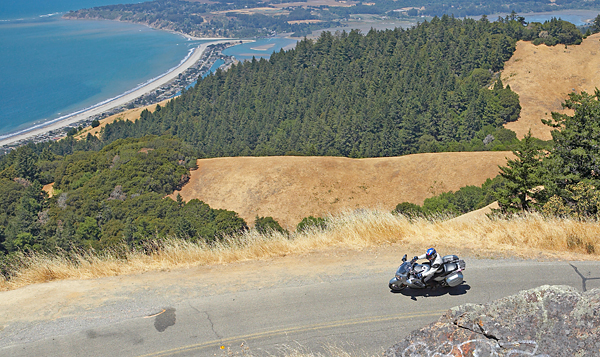
That opinion is this. Kawasaki has hit a home run. Frankly, this is one of the best motorcycles I have ever tested. Sometimes, technology is thrown at a bike and it does nothing more than make the spec sheet look impressive. The technology on the Concours 14 works in the way it should work . . . by staying in the background, doing its job quietly, and not detracting from the overall riding experience. You know it’s there (the pulsing of the rear brake pedal while riding the bike aggressively is the most frequent reminder), but it makes its presence known in an almost charming way, and you know it is allowing you to ride the bike faster and safer.
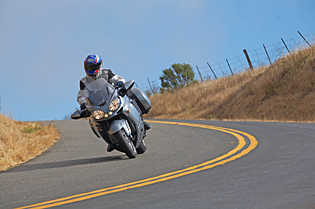
The combination of comfort and sportiness offered by this bike is beyond anything else I have experienced. There are more comfortable bikes (in the luxury tourer class), and there are pure sport machines, but the Concours 14 has managed to marry these two elements in a unique, almost disarming manner.
The Concours 14 is available only in the color shown (Neutron Silver) here in the United States, and the U.S. MSRP is $12,899.00 without ABS, and $13,799.00 with ABS. The Concours 14 is available now at U.S. dealerships. For additional details and specifications, visit Kawasaki’s web site





